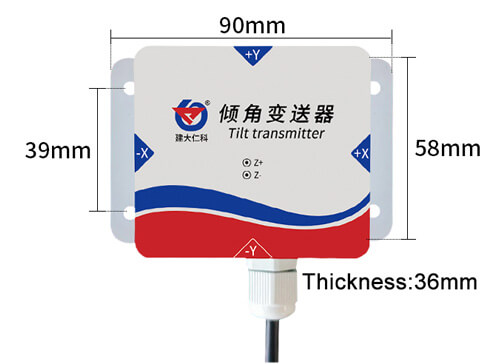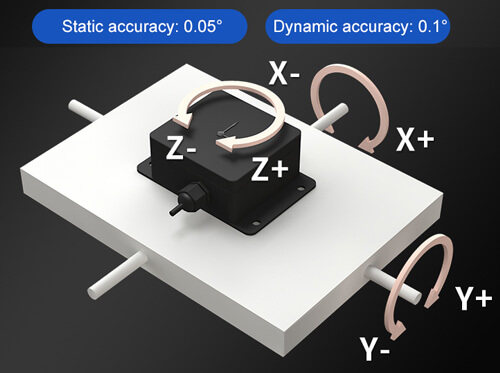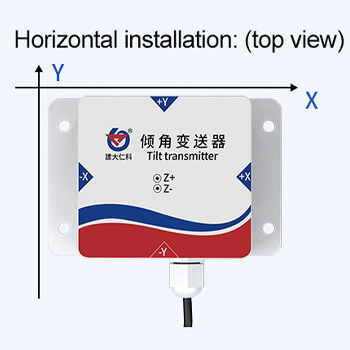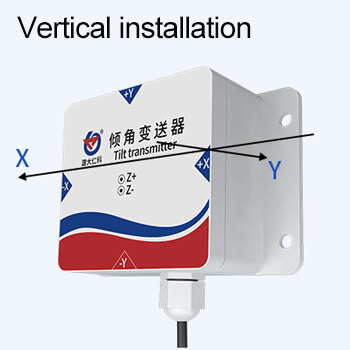For Downloads | Data Sheet – User Manual – Other Documents – Certificates | |
| Setup Software | Testing Software |
For Purchase | Call / WhatsApp / Telegram: +91 8148834200 | |
For Technical Support | Call / WhatsApp / Telegram: +91 8148834211 | |

Is a standard industrial dual-axis inclinometer, which adopts various installation methods and is suitable for use in different places. Meet the various needs of customers for measurement range, signal and environmental conditions. The tilt sensor adopts standard Modbus protocol RS485 signal output. The housing of the tilt sensor is made of sturdy waterproof material and can work in harsh environments.
Tilt Sensor, Inclinometer

This tilt sensor is an instrument used to measure the multi-axis tilt of a reference plane. The inclinometer converts the change of the tilt angle by measuring the static gravitational acceleration, so as to measure the tilt rate and angle of the sensor relative to the horizontal plane. It can easily detect orientation or tilt. It is widely used in industrial inclination measurement and dangerous building monitoring, ancient building protection monitoring, bridge tower inclination measurement, tunnel monitoring, dam monitoring, weighing system inclination compensation, drilling inclination control and other industries. Beautiful appearance and easy installation.
Tilt sensor features

·
Using the Kalman filter algorithm, the accuracy is up to 0.05°
·
It has a wide-angle measurement range and good output signal linearity,
which can be used in most environments.
·
Dual-axis inclinometer for horizontal and vertical mounting
·
The overall housing of the tilt sensor is waterproof and
corrosion-resistant. Design appearance suitable for harsh environments
· Various technologies including MEMS, fluid-based, and potentiometer designs
Installation - Tilt Sensor, Inclinometer


|
Power |
DC
5-30V |
|
Range |
X, Z:
-180°~180°, Y: -90°~90° |
|
Resolution |
0.01° |
|
Accuracy |
X, Y
axis: static accuracy ±0.1°, dynamic accuracy ±0.5°, Z axis: static accuracy ±0.5° |
|
Protection |
IP65 |
|
Cable |
60cm,
can be customized |
|
Output |
RS485 |
The default installation direction of the tilt sensor is horizontal installation. When the module needs to be placed vertically, it can be installed vertically. Vertical installation method: When installing vertically, rotate the module 90° around the X axis and place it vertically, and select “Vertical” in the “Installation Direction” option in the configuration column of the host computer. After the setting is completed, it needs to be calibrated before it can be used. When installed vertically, the X-axis is horizontal to the left, the Y-axis is perpendicular to the wall, and the Z-axis is the counter clockwise rotation direction of the module.
Inclinometer instructions

Please install the inclinometer according to the correct installation
method. Improper installation will cause measurement errors.
The installation surface of the tilt sensor and the surface to be
measured must be fixed tightly and flat. If the installation surface is uneven,
it will easily cause the measurement angle error of the transmitter.
The axis of the sensor and the axis to be measured must be parallel, and the two axes should not create an angle as much as possible.
FAQ - Tilt Sensor, Inclinometer
How many outputs does the tilt sensor
have?
·
Single Axis, Single Output: The sensor responds to tilting about a
horizontal axis, relative to downward gravity.
· Dual axis, dual output: The sensor consists of two sensing elements angled at 90 degrees to each other.
What are the types of tilt sensors?
According to the structure and working principle, it can be divided into three types: single-axis single-output, dual-axis dual-output and dual-axis single-output.
How to install the
tilt sensor to ensure its best accuracy?
When installing, keep the mounting surface of the sensor parallel to the measured surface and reduce the influence of dynamics and acceleration on the sensor. The inclinometer can be installed horizontally or vertically. Vertical installation is suitable for single-axis tilt sensors, and horizontal installation is used for inclinometers with a range of <60 degrees. The front of the sensor is marked with X and Y direction indicator stickers, which can be referred to during installation.
Which direction do
uniaxial and biaxial measurements refer to?
Dual axis can measure roll angle (X direction) and pitch angle (Y direction). When the single axis is selected for horizontal installation, only the flip angle or pitch angle can be measured. If the single axis is selected for vertical installation, only the flip angle can be measured, but the pitch angle cannot be measured.
How can the actual
angle of the electronic compass be larger than the measured angle?
Since the two axes of inclination measurement are the most sensitive, when the inclination direction is not parallel to the measurement axis, the actual value will be larger than the measured value, which can also be understood as projection.
The larger the
range of the inclinometer sensor, the better?
No, the range size and accuracy will
be inversely proportional, the smaller the range, the higher the accuracy.
Industrial Tilt Sensor Inclinometer
- Brand: renke
- Product Code: RS-DIP-N01-1
- Availability: In Stock
-
Rs.6,500.00
Tags: Industrial, Tilt, Sensor, Inclinometer






